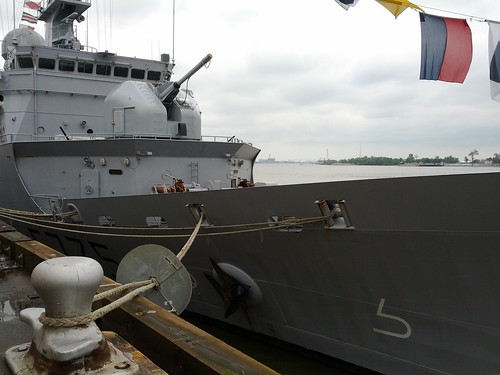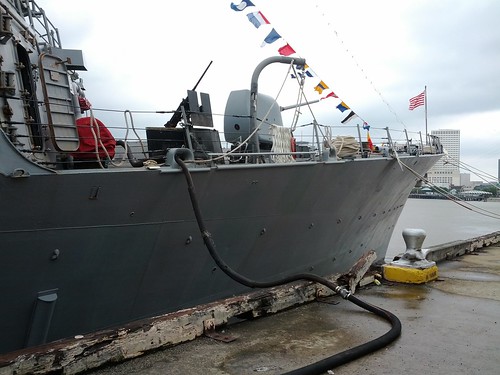I had a little detail I wanted to point out that I noticed in Navy Week.
First off, what is Naval Architecture? Well, ABET recognizes 3 very closely-related disciplines: Naval Architecture, Marine Engineering, and Ocean Engineering. Naval Architecture generally concerns hull forms, Marine Engineering usually concerns engines, propulsion, and ship systems, and Ocean Engineering is sort of civil and mechanical at sea. Here's a nice little paper describing more along these lines.
So, one of the things I noticed this weekend was the differences in hull geometry between the 3 vessels at the Governor Nicholls Wharf. In the photo below, the USS Mitscher is first, followed by the USS DeWert, with the French Frigate Germinal last:

The DeWert is the oldest design of the three. It's an Oliver Hazard Perry-class frigate. It has a hull geometry that was very similar to WWII-era designs. As a result, its sea-keeping abilities leave something to be desired. Here are some photos of a Knox-class frigate, the OHP-class predecessor, trying to cope with 45'+ waves. "Green water over the bow" is when you start to really get worried. Here are some even more amazing photos of similar-sized military ships coping with big waves.
I got to talking with a seaman on the DeWert and he wished the ship had a wider beam. There are three stages of sea-sickness: seasick, so seasick you're afraid you're going to die, and so seasick you're afraid you AREN'T going to die and it will never end. You could tell he'd been the third category of seasick at some point in his naval career.
The other two vessels are much more modern and had some interesting design characteristics to cope with heavy seas.
The FS Germinal had a double-decked bow. More photos here.


The lower deck held the anchor-handling gear (windlass, etc.) and the upper deck held the armament (something you really don't want getting wet). The lower deck you can tell is regularly awash, due to the extensive corrosion. The advantage is there's less of the bow to get sucked-under when it does go awash and the upper deck stays much dryer. The disadvantage is the lower deck is regularly awash and I'd be willing to guess the design is a bit heavier.
The Mitscher is the largest of the three vessels, but not by that much. From talking with the destroyer's crew, it is a very, very seaworthy vessel. One of the main reasons is the intricate chine on the bow:

It was the result of a lot of studies of behavior of especially OHP-class ships in the North Atlantic. The design keeps the deck relatively dry by allowing just enough movement, but not so much that either the crew get seasick or the sonar-dome goes out of the water.
So, if you're a Naval Architect, these are the sorts of decisions that you need to make. The net result of all the decisions and compromises results in the final design of the ship.
NOTE- Some updates after publishing
3 comments:
Latorre left out URI which started the whole OCean Engineering thing. Shame!
Wonderful blog & good post.Its really helpful for me, awaiting for more new post. Keep Blogging!
Naval Architecture Academy
My cousin recommended this blog and she was totally right keep up the fantastic work!
Naval Architecture
Post a Comment